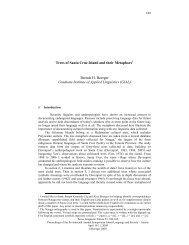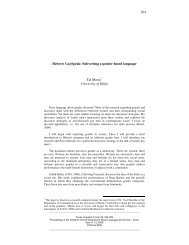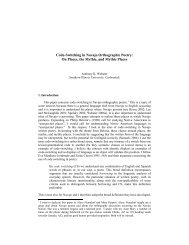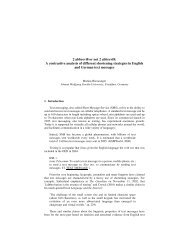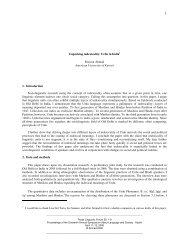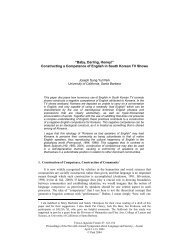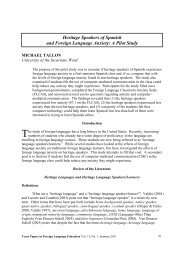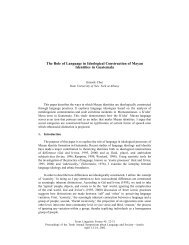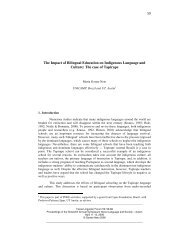Diversity and Intersectionality Sonja L. Lanehart University of Texas ...
Diversity and Intersectionality Sonja L. Lanehart University of Texas ...
Diversity and Intersectionality Sonja L. Lanehart University of Texas ...
Create successful ePaper yourself
Turn your PDF publications into a flip-book with our unique Google optimized e-Paper software.
<br />
According to Crenshaw (1991, p. 1244), there are three ways <strong>of</strong> conceptualizing<br />
interesectionality: structural, political, <strong>and</strong> representational. Structural intersectionality<br />
proposes that strategies based solely on the experiences <strong>of</strong> women who do not share the<br />
same class or race backgrounds will be <strong>of</strong> limited help to women who because <strong>of</strong> race <strong>and</strong><br />
class face different obstacles (Crenshaw, 1991, p. 1246). This was <strong>and</strong> is a divide that<br />
exists within the feminist movement <strong>and</strong> that led women <strong>of</strong> color groups to emerge as<br />
separate from white women’s groups: Black women, Latinas, etc. have many struggles in<br />
common with white women, but they also have many more struggles not in common<br />
because we live in not only a sexist society but also a racist <strong>and</strong> classist one. Hence, the<br />
feminist movement is not big enough, not inclusive enough for women <strong>of</strong> color. As<br />
Crenshaw (1991, p. 1250) asserts, women <strong>of</strong> color occupy positions both physically <strong>and</strong><br />
culturally marginalized within dominant society, <strong>and</strong> so methods must be targeted directly<br />
to them in order to reach them.<br />
According to Crenshaw (1991, p. 1252), political intersectionality proposes that<br />
women <strong>of</strong> color are situated within at least two subordinated groups that frequently pursue<br />
conflicting political agendas. The need to split one's political energies between two,<br />
sometimes opposing, groups is a dimension <strong>of</strong> intersectional disempowerment that men <strong>of</strong><br />
color <strong>and</strong> white women seldom confront. Because women <strong>of</strong> color experience racism in<br />
ways not always the same as those experienced by men <strong>of</strong> color <strong>and</strong> sexism in ways not<br />
always parallel to experiences <strong>of</strong> white women, antiracism <strong>and</strong> feminism are limited, even<br />
on their own terms. Sexual stratification theory posits that women are stratified sexually<br />
by race. In traditional sociolinguistic studies on African American Language, Black men<br />
have been more favored in research than Black women because, for some, they have been<br />
seen as the true arbiters <strong>of</strong> African American Language. Only more recent research has<br />
focused on Black women (e.g., Jacobs-Huey, 2006; <strong>Lanehart</strong>, 2002, 2009; Troutman,<br />
2001; Morgan, 1991, 1996, 1999, 2002). This seems unconscionable given that men <strong>and</strong><br />
women are Black <strong>and</strong> both use language. To negate the existence <strong>and</strong> experience <strong>of</strong> one or<br />
to subordinate it is contrary to the goals <strong>of</strong> sociolinguistics <strong>and</strong> ELS.<br />
The failure <strong>of</strong> feminism to interrogate race means that the resistance strategies <strong>of</strong><br />
feminism will <strong>of</strong>ten replicate <strong>and</strong> reinforce the subordination <strong>of</strong> people <strong>of</strong> color, <strong>and</strong> the<br />
failure <strong>of</strong> antiracism to interrogate patriarchy means that antiracism will frequently<br />
reproduce the subordination <strong>of</strong> women (Crenshaw, 1991, p. 1252). Likewise, race-based<br />
priorities function to obscure the issues <strong>of</strong> women <strong>of</strong> color; feminist concerns <strong>of</strong>ten<br />
suppress minority experiences as well.<br />
According to Crenshaw (1991, p. 1283), representational intersectionality purports<br />
that race <strong>and</strong> gender converge so that the concerns <strong>of</strong> minority women fall into the void<br />
between concerns about women's issues <strong>and</strong> concerns about racism. Debates over<br />
representation continually elide the intersection <strong>of</strong> race <strong>and</strong> gender in the popular culture’s<br />
construction <strong>of</strong> images <strong>of</strong> women <strong>of</strong> color. Accordingly, an analysis <strong>of</strong> what may be<br />
termed "representational intersectionality" would include both the ways in which these<br />
images are produced through a confluence <strong>of</strong> prevalent narratives <strong>of</strong> race <strong>and</strong> gender, as<br />
well as a recognition <strong>of</strong> how contemporary critiques <strong>of</strong> racist <strong>and</strong> sexist representation<br />
marginalize women <strong>of</strong> color (Crenshaw, 1991, p. 1283).<br />
In summary, an intersectional analysis argues that: (1) racial <strong>and</strong> sexual subordination<br />
are mutually reinforcing; (2) Black women are commonly marginalized by a politics <strong>of</strong><br />
race alone or gender alone; <strong>and</strong> (3) a political response to each form <strong>of</strong> subordination must<br />
at the same time be a political response to both (Crenshaw, 1991, p. 1283).<br />
2 An Example <strong>and</strong> Explanation<br />
<br />
<strong>Texas</strong> Linguistic Forum 53: 1-7<br />
Proceedings <strong>of</strong> the Seventeenth Annual Symposium About Language <strong>and</strong> Society – Austin<br />
April 10-11, 2009<br />
©<strong>Lanehart</strong> 2009<br />
5



